En båtanmeldelse fra Nautical web
AMEL YARD - SUPER MARAMU
 The sea trials of the Super Maramu took place in a 30/35-knot wind
and a very rough sea. This yacht is a GRP ketch, built by the
notorious and widely appreciated French yard Amel. We went to
Hyères, on the southern coast of France, where the yard has its own
servicing pier and where it moors its queens of the sailing world.
The sea trials of the Super Maramu took place in a 30/35-knot wind
and a very rough sea. This yacht is a GRP ketch, built by the
notorious and widely appreciated French yard Amel. We went to
Hyères, on the southern coast of France, where the yard has its own
servicing pier and where it moors its queens of the sailing world.
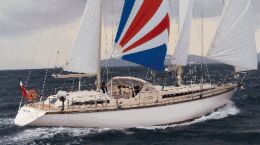 This was a special occasion for verifying the seaworthiness and
maneuverability of a boat that maintains her promises and that might
offer even more. Traditionalist sailors dislike of technological
interpretations of sailing boats is more a matter of prejudice than
of mental disposition. Innovations such as mainsail and jib
roller-reefing systems, bow thruster, electrical winches, power
assisted blocks, automatic pilots and whatever is technologically
new and is applied to a sailing boat worry them.
This was a special occasion for verifying the seaworthiness and
maneuverability of a boat that maintains her promises and that might
offer even more. Traditionalist sailors dislike of technological
interpretations of sailing boats is more a matter of prejudice than
of mental disposition. Innovations such as mainsail and jib
roller-reefing systems, bow thruster, electrical winches, power
assisted blocks, automatic pilots and whatever is technologically
new and is applied to a sailing boat worry them.
 Yet, I suggest them to jump onboard the Super Maramu where they will
certainly change their minds and overcome old prejudices that should
not apply to these technological solutions. If we had to summarize
in a few words our opinion of this 52'6" footer Amel, we could say
that we tested a fast close-hauling boat. She is very performing
(maximum speed of 11 knots with 30- knot gusts with an angle with
the wind of not more than 20-22 degrees) and is very maneuverable.
Actually, the Super Maramu (average annual production of 40 units)
concentrates technological innovations and patents tested and tuned
by the engineering staff of the yard and surveyed by the aged, yet
dynamic, Monsieur Amel. Let us not be too lengthy, data and
photographs speak better than words. Let me just give an advice:
whoever has a little less than a billion liras to spend for a big
cabin cruiser should go to Hyères!
Yet, I suggest them to jump onboard the Super Maramu where they will
certainly change their minds and overcome old prejudices that should
not apply to these technological solutions. If we had to summarize
in a few words our opinion of this 52'6" footer Amel, we could say
that we tested a fast close-hauling boat. She is very performing
(maximum speed of 11 knots with 30- knot gusts with an angle with
the wind of not more than 20-22 degrees) and is very maneuverable.
Actually, the Super Maramu (average annual production of 40 units)
concentrates technological innovations and patents tested and tuned
by the engineering staff of the yard and surveyed by the aged, yet
dynamic, Monsieur Amel. Let us not be too lengthy, data and
photographs speak better than words. Let me just give an advice:
whoever has a little less than a billion liras to spend for a big
cabin cruiser should go to Hyères!
 TECHNICAL
DATA TECHNICAL
DATA
 Designer:
Naval Architects H. Amel and J. Carteau Designer:
Naval Architects H. Amel and J. Carteau
Yard: Amel Yards, La Rochelle, 17185 Périgny Cedex, France;
tel. +33-46-551731, fax +33-46-454303 (France)
Gross tonnage:
29.55 tons
L.O.A.: 52'6"
LWL: 41'4"
Beam: 15'
Draft: 6'8"
Light displacement:
13.78 tons
Power: 80 hp Volvo Penta Turbo Diesel
Maximum speed under power: 8 knots
Maximum theoretical sailing speed:
10/12 knots
Freshwater tank: 264 gallons
 Bathrooms:
2 Bathrooms:
2
Berths: 6/8 in 3/4 cabins
Rigging: ketch
Main mast: 65'7"
Mizzen mast: 45'11"
Sail area: 1280 sqft
 Jib:
699 sqft Jib:
699 sqft
Mizzen: 204 sqft
Mizzen jib: 333 sqft
Spinnaker: 731 sqft
Price: FF 2,800,000 ex VAT.
 CONSTRUCTION CHARACTERISTICS
CONSTRUCTION CHARACTERISTICS
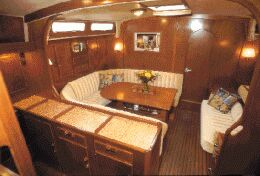 Keel:
lead with small fins and Amel propelling system Keel:
lead with small fins and Amel propelling system
Hull and deck:
special Amel stratified GRP, composite
materials, wood; After peak and forward peak with two watertight
bulkheads
Rudder: stainless steel blade
Hardware:
Amel and other excellent trademarks
Running rigging: all halyards and lines are led to the
cockpit, in the central part of the boat
Inflatable raft: stowed on portside of cockpit, with line and
fitting for quick lifting
Swimming ladder: teak and stainless steel swimming ladder to
be used on the side of the boat and convertible in gangway.
 IMPRESSIONS
IMPRESSIONS
SEA AND WEATHER CONDITIONS DURING BOAT TESTING
Wind: 25/30 knots
Sea: rough
 STEERING
PERFORMANCE STEERING
PERFORMANCE
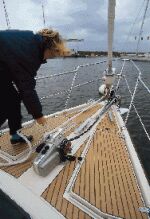 Visibility:
excellent in all conditions Visibility:
excellent in all conditions
close-hauled and abeam: excellent upwind performance, due to her
sail surface used during sea trials. When sailing cross wind she is
very light
Running and broad reaching: due to the strong wind, we could
not hoist the spinnaker, nevertheless, the boat showed excellent
lift with four sails set
Course steadiness: precise maneuvers are possible with the
steering wheel, even on waves.
Wave impact: the hull crosses the waves in a comfortable and
decisive manner
Under power: excellent performing capabilities thanks to the
quality of the propelling unit and its leg. The choice of a variable
pitch propeller was excellent. The yard paid special attention to
the propelling unit and because of this the cruising speed under
power is of 7 knots. She could be compared to a motor- sailer with
limited noise of engine even at high speed.
Engine vibration:
irrelevant, thanks to the excellent noise
insulation
Docking maneuverability: excellent. The recessed 10-hp bow
thruster is controlled by a joystick. Docking in a 30-knot stern
wind is possible without using the steering wheel!
 OVERALL
IMPRESSIONS OVERALL
IMPRESSIONS
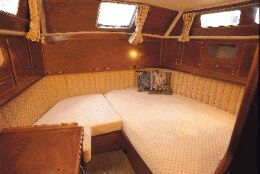 Hull Design:
Naval Architects Amel and Carteau, who designed the
boat, succeeded in meeting two main requirements: fun and comfort.
For this aim, they designed a hull that is very sensitive to
stresses and has excellent performing capabilities. The
winged-shaped keel with bulb, designed by Amel, better counteracts
the pressure generated by the sails Hull Design:
Naval Architects Amel and Carteau, who designed the
boat, succeeded in meeting two main requirements: fun and comfort.
For this aim, they designed a hull that is very sensitive to
stresses and has excellent performing capabilities. The
winged-shaped keel with bulb, designed by Amel, better counteracts
the pressure generated by the sails
Sail plan: standard sails include the mainsail, mizzen, jib,
mizzen jib and spinnaker. During sea trials we could not test the
spinnaker but we set the other four sails at all points of sail. The
standard sail area is definitely sufficient for sailing in all
conditions
Deck: the roller-reefing mainsail and headsail together with
the steering wheel make the central cockpit the main operative
position. The cockpit is very comfortable. Deck fittings are of very
good quality and all lines are neatly led through the blocks. The
standard dodger that may be folded in the cockpit is an interesting
solution and it integrates very well in the outside line of the
boat.
 EVALUATION OF CONSTRUCTION
EVALUATION OF CONSTRUCTION
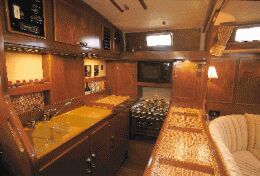 Building materials:
high-quality composite materials. Building materials:
high-quality composite materials.
Finishing: very good both on deck as well as belowdeck,
mainly due to the 50-year experience of the yard in boatbuilding.
Interior layout: the drawings include three separated areas:
forward, amidships and aft, two bathrooms near the forward and the
aft cabins, an ample dinette with a fully equipped worktop. The
chart table is separated and large, opposite the storeroom. Interior
decor is elegant because of the large use of wooden doors, bulkheads
and linings (African mahogany). There are several lockers, drawers
and open storing spaces that are very useful on cruisers of this
type. In addition, innovations such as the refrigerator/ice box
under the dinette settee, the cable locker-cover stops and the
movable footrest in the toilet compartment to be used when sailing
close-hauled are very useful and practical.
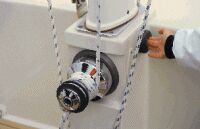 Deck:
fore-and-aft passage: very good. The shrouds do not hinder
fore-and-aft passage. Anti-slipping material: excellent. The brown
anti-slipping material on deck has a greater gripping effect than
teak. The cockpit floor and the deck throughout are made of this
special material that could be erroneously called "false teak".
Actually, it has a better gripping effect than teak and no
maintenance requirements Deck:
fore-and-aft passage: very good. The shrouds do not hinder
fore-and-aft passage. Anti-slipping material: excellent. The brown
anti-slipping material on deck has a greater gripping effect than
teak. The cockpit floor and the deck throughout are made of this
special material that could be erroneously called "false teak".
Actually, it has a better gripping effect than teak and no
maintenance requirements
Stanchions: strong and safe stainless steel molded-in
stanchions
Grabrails: all shrouds are sheathed in running nylon
protection sleeves of different diameter
Foredeck arrangement:
clean and practical. Chain roller,
electrical windlass with support, stainless steel anchor chain and
anchor are fitted. The anchor chain is automatically washed. Safety:
excellent in the tested boat, especially due to the
toe-rail molded in the GRP which serves as a firm foot brace on
deck.
 Anchor locker:
not contemplated because the anchor is blocked in
place in a stainless steel fitting Anchor locker:
not contemplated because the anchor is blocked in
place in a stainless steel fitting
Fairleads: practically located, outside the railings, on the
upper edge of the toe-rail
Mooring bitts and cleats: 6, 2 forward and 4 aft. Rigging and
fittings
Mast: mast and mizzen mast with roller-reefing systems
Boom: Amel regulation of the mainsail sheet. No vang
Shrouds:
first-quality and well positioned.
Sails: tri-radial; 2 fully rigged spinnaker poles and two
smaller integrated Amel poles. Headsail protection.
Steering:
wheel steering
Headsail reefing: standard electrical roller-furling system
with remote control in the cockpit
Mainsail reefing: standard electrical roller-furling system
 Winches:
7 Amel/other excellent trademarks Winches:
7 Amel/other excellent trademarks
Headsail lead blocks:
2, suitably positioned.
Mainsheet traveler: of small size, on the coachroof
Engine controls: one throttle lever with on/off key and one
fuel closing switch to port of the wheel in the forward part of the
cockpit
Sailing instruments: instruments panel belowdeck with
instrument indicators on deck for boat speed, wind speed, wind
angle, and B&G echo-sounder; Autohelm automatic pilot (double upon
request); day vision radar; GPS, VHF, Sonic Speed log with video,
watch, barometer, compass
Engine instruments: electrical fuel level gauge and full data
instruments.
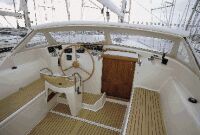 Cockpit
Cockpit
Design: spacious, along the boat's centerline. Side settees,
a pilot's seat and a removable wooden table are fitted
Comfort:
very good for 6 persons plus the helmsman
Helm station:
excellent visibility, comfortable above all
when standing. Pilot's seat is fitted
Engine noise during cruising:
scarcely audible because of
noise-insulation of engine room
Engine vibration during cruising:
almost none
Lockers: two forward, one in the cockpit and a big one aft
for inflatable raft storage
Cockpit table: large. The table has a wooden top and
stainless steel legs
Shower on deck: contemplated
Inflatable raft:
stored in the aft portside locker
Swimming ladder: contemplated, to be fitted on the side of
the hull; it is convertible in gangway when boat is docked
Companionway
Accessibility: good with sliding hatch
Safety: excellent. Secure steps, stainless steel grabrails,
anti-slipping deck
Weather tightness: good due to the surrounding double sill
Closing system: wooden hatch with locking key
 Dinette
Dinette
Headroom: max. 6'8"
Comfort: excellent for 6/8 persons, convertible in berths for
2 persons
Ventilation: excellent. Independent air conditioners for hot
and cold air are fitted in each cabin
Natural lighting: good due to several portholes and hatches
Artificial lighting: plenty. Spotlights, overhead and
embedded lights are fitted
Interior handholds: suitably positioned
Lockers and shelves: several. Drawers, shelves and lockers
are fitted in all cabins. Several hanging lockers are provided
Engine vibration during cruising: slight yet not disturbing
Locker volume: enough for long crossings
Chart table:
large, with stool, light, digital control
dashboard and several storing spaces
Space for electronic instruments:
easy access (including the
radar). Instruments may be easily removed for maintenance
Natural lighting:
fair because the hatch remains on the back
an on starboardside of the person sitting at the chart table
Artificial lighting:
good. Embedded lights and a rotating
spotlight are fitted
Safety: good
Engine vibration during cruising:
scarcely audible
Locker volume: excellent.
 Forward stateroom
Forward stateroom
Headroom: 6'3"
Berth overhead:
excellent
Bed length: 5'11"
Ventilation:
good due to the manhole
Natural lighting: good
Artificial lighting:
sufficient
Locker volume: several useful lockers of different sizes
Engine vibration during cruising: absent.
Aft master stateroom
Headroom: 6'3"
Berth overhead:
excellent
Bed length: 6'3"-6'7"
Ventilation:
fair
Natural lighting: excellent
Artificial lighting:
good
Locker volume: adequate for long crossings
Engine vibration during cruising:
noticeable, especially when
running above average speed.
Third stateroom
Ventilation: less than in the other two staterooms
Natural lighting: poor
Artificial lighting: good
Locker volume: minimal because the locker under the bed
contains the batteries
Engine vibration during cruising: minimal.
Galley
Sink: double sink
Freshwater: cold and hot water
Seawater: contemplated
Range: stainless steel gimbaled range with two gas burners
and oven
Extractor: contemplated with filter plus opening porthole
above the galley
Worktop: large worktop with mosaic design
Refrigerator: an electrical refrigerator is contemplated
together with a second refigerator/freezer. In addition, a
dishwasher and a washing machine are installed
Locker volume:
plenty of space
Comfort: like an average household kitchen
Ventilation: opening porthole over the range and near the
companionway
Natural lighting: very good
Artificial lighting:
embedded lights and spotlights
Safety: excellent
Engine vibration during cruising: slight.
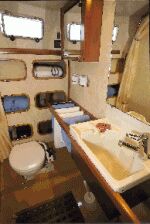 Bathrooms
Bathrooms
Sink: in GRP
Comfort: very good, bathrooms are roomy
Toilet: manual
Locker volume: considerable
Ventilation:
good, with opening porthole
Natural lighting: good
Artificial lighting: fair, embedded lights are fitted
Engine vibration during cruising:
minimal, perceptible aft.
The movable footrests are practical and the wood finishing is very
pleasant.
Engine room
the engine room is very roomy with almost enough headroom to stand
upright
Noise insulation: excellent, as on motor yacht
Access: good front access, excellent side access, excellent
top and bottom access
Oil gauge access: good
Reversing gear access:
excellent
Ventilation: ventilation is produced by an electrical
fan.Auxiliaries
Electrical panel: easy comprehension. It is a bit too high
over the galley top
Electrical plant: 220V electric circuit with electronic
battery charger
Batteries: 9
Fuel tank: 160 gallons
Freshwater tank: large (266 gallons)
Bilge pump: automatic
Hydraulic plant: excellent.
|





 The sea trials of the Super Maramu took place in a 30/35-knot wind
and a very rough sea. This yacht is a GRP ketch, built by the
notorious and widely appreciated French yard Amel. We went to
Hyères, on the southern coast of France, where the yard has its own
servicing pier and where it moors its queens of the sailing world.
The sea trials of the Super Maramu took place in a 30/35-knot wind
and a very rough sea. This yacht is a GRP ketch, built by the
notorious and widely appreciated French yard Amel. We went to
Hyères, on the southern coast of France, where the yard has its own
servicing pier and where it moors its queens of the sailing world.
 This was a special occasion for verifying the seaworthiness and
maneuverability of a boat that maintains her promises and that might
offer even more. Traditionalist sailors dislike of technological
interpretations of sailing boats is more a matter of prejudice than
of mental disposition. Innovations such as mainsail and jib
roller-reefing systems, bow thruster, electrical winches, power
assisted blocks, automatic pilots and whatever is technologically
new and is applied to a sailing boat worry them.
This was a special occasion for verifying the seaworthiness and
maneuverability of a boat that maintains her promises and that might
offer even more. Traditionalist sailors dislike of technological
interpretations of sailing boats is more a matter of prejudice than
of mental disposition. Innovations such as mainsail and jib
roller-reefing systems, bow thruster, electrical winches, power
assisted blocks, automatic pilots and whatever is technologically
new and is applied to a sailing boat worry them.  Yet, I suggest them to jump onboard the Super Maramu where they will
certainly change their minds and overcome old prejudices that should
not apply to these technological solutions. If we had to summarize
in a few words our opinion of this 52'6" footer Amel, we could say
that we tested a fast close-hauling boat. She is very performing
(maximum speed of 11 knots with 30- knot gusts with an angle with
the wind of not more than 20-22 degrees) and is very maneuverable.
Actually, the Super Maramu (average annual production of 40 units)
concentrates technological innovations and patents tested and tuned
by the engineering staff of the yard and surveyed by the aged, yet
dynamic, Monsieur Amel. Let us not be too lengthy, data and
photographs speak better than words. Let me just give an advice:
whoever has a little less than a billion liras to spend for a big
cabin cruiser should go to Hyères!
Yet, I suggest them to jump onboard the Super Maramu where they will
certainly change their minds and overcome old prejudices that should
not apply to these technological solutions. If we had to summarize
in a few words our opinion of this 52'6" footer Amel, we could say
that we tested a fast close-hauling boat. She is very performing
(maximum speed of 11 knots with 30- knot gusts with an angle with
the wind of not more than 20-22 degrees) and is very maneuverable.
Actually, the Super Maramu (average annual production of 40 units)
concentrates technological innovations and patents tested and tuned
by the engineering staff of the yard and surveyed by the aged, yet
dynamic, Monsieur Amel. Let us not be too lengthy, data and
photographs speak better than words. Let me just give an advice:
whoever has a little less than a billion liras to spend for a big
cabin cruiser should go to Hyères!  Designer:
Naval Architects H. Amel and J. Carteau
Designer:
Naval Architects H. Amel and J. Carteau Bathrooms:
2
Bathrooms:
2 Jib:
699 sqft
Jib:
699 sqft Keel:
lead with small fins and Amel propelling system
Keel:
lead with small fins and Amel propelling system Visibility:
excellent in all conditions
Visibility:
excellent in all conditions Hull Design:
Naval Architects Amel and Carteau, who designed the
boat, succeeded in meeting two main requirements: fun and comfort.
For this aim, they designed a hull that is very sensitive to
stresses and has excellent performing capabilities. The
winged-shaped keel with bulb, designed by Amel, better counteracts
the pressure generated by the sails
Hull Design:
Naval Architects Amel and Carteau, who designed the
boat, succeeded in meeting two main requirements: fun and comfort.
For this aim, they designed a hull that is very sensitive to
stresses and has excellent performing capabilities. The
winged-shaped keel with bulb, designed by Amel, better counteracts
the pressure generated by the sails Building materials:
high-quality composite materials.
Building materials:
high-quality composite materials.  Deck:
fore-and-aft passage: very good. The shrouds do not hinder
fore-and-aft passage. Anti-slipping material: excellent. The brown
anti-slipping material on deck has a greater gripping effect than
teak. The cockpit floor and the deck throughout are made of this
special material that could be erroneously called "false teak".
Actually, it has a better gripping effect than teak and no
maintenance requirements
Deck:
fore-and-aft passage: very good. The shrouds do not hinder
fore-and-aft passage. Anti-slipping material: excellent. The brown
anti-slipping material on deck has a greater gripping effect than
teak. The cockpit floor and the deck throughout are made of this
special material that could be erroneously called "false teak".
Actually, it has a better gripping effect than teak and no
maintenance requirements Anchor locker:
not contemplated because the anchor is blocked in
place in a stainless steel fitting
Anchor locker:
not contemplated because the anchor is blocked in
place in a stainless steel fitting Winches:
7 Amel/other excellent trademarks
Winches:
7 Amel/other excellent trademarks Cockpit
Cockpit Dinette
Dinette Forward stateroom
Forward stateroom Bathrooms
Bathrooms